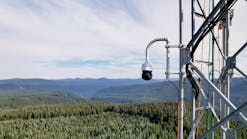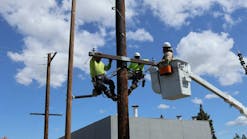What lays between wildfire prevention and mitigation? Wildfire detection.
Wildfire prevention and wildfire mitigation include similar activities by a utility, and the goal, whether to prevent or to mitigative, focuses on minimizing the involvement of utility equipment. But the fact remains that despite these efforts, wildfires will occur. However, when wildfires do occur, the key to minimizing its size, resulting destruction, and personal injury is rapid detection. Rapid detection results in faster fire responses and smaller fires to contain.
Power Line Wildfires
Wildfires initiated by power lines are on average ten times larger than fires started by other means.[1] Power line arcing or other forms of utility equipment failure are often initiated by wind events. These same wind events contribute to the wildfire’s spread and consequent devastation. Utility rights-of-way and the unique risks associated with them call for defensive fire detection methods. Defensive fire detection is rapid fire detection and reporting to ensure that firefighting resources will arrive to the smallest possible fire.
The FIREBird system, by Lindsey FireSense, is specifically designed to detect small wildfires and rapidly report on their presence, typically in under 2 minutes. When placed at regular intervals, FIREBird devices provide continuous wildfire detection along critical, high fire risk boundaries such as utility rights-of-way, easements associated with roadways, or wildland-urban interfaces where neighborhoods adjoin fuel-rich wildlands. FIREBird systems can also be deployed around critical assets such as substation or control center perimeters.
Various wildfire detection systems and programs have been introduced with the intent of identifying wildfires from a distance, commonly by looking for plumes of smoke. This type of approach to wildfire detection may provide limited effectiveness, particularly at night. FIREBird devices provide a highly localized, “in situ” approach to wildfire detection. The FIREBird system is specifically designed to quickly and autonomously detect very small nearby fires, as well as larger fires at a distance, providing a scalable solution. And unlike some wildfire detection systems, FIREBird is not constrained by the need for daylight; it detects wildfires at any time of day.
FIREBird; A 24x7 Guardian
Each FIREBird device provides continuous, 360-degree, monitoring provided by 8 wildfire-specific thermal detectors and 6 optical cameras[2].
Multiple advanced neural-network algorithms running on the FIREBird device provide local determination of abnormal heat and fire events. These algorithms minimize the likelihood of false or missed detections. All the computing power needed for simultaneous sensor sampling and processing of the advanced neural networks is contained within each FIREBird, resulting in the fastest fire detection possible.
Each FIREBird sensor can detect wildfires across an almost 1000’ radius, resulting in a 60-acre detection zone. Wildfires as small as 5 x 5 feet can be detected within 200 feet.
Fast, Unmanned, Autonomous Detection
The FIREBird system is entirely self-contained. The system’s continuous 24x7 operation requires no monitoring and therefore no increase in staff levels to monitor and interpret the results. Automatic notification by text and/or email along with images of the fire or any suspected heat event is sent directly to designated personnel.
Each FIREBird integrates a CAT-1 LTE cellular radio which operates on commercial cellular networks. Built-in backup communications via the Iridium satellite network are also available. Each unit is supplied with a battery-backed solar power supply. Fully integrated communication, power, computing power, and use of cloud-based computing for data storage and reporting, means there is no requirement for the system to depend upon – or even to interface - with a user’s IT or communications infrastructure. This speeds implementation and removes any cyber-security risks from more intrusive implementations.
More Than Just Wildfire Detection
Once a heat or fire event is detected, the FIREBird’s cameras capture six overlapping images, providing a 360-degree view of the surrounding area, potentially providing important documentation regarding the cause of an event.
Each FIREBird device can also provide high accuracy measurements of fire-critical weather data including windspeed, wind direction, ambient temperature, and humidity. Weather data is available during normal conditions, as well as after a fire is detected.
Simplifying Power Restoration After Public Safety Power Shutoff (PSPS) Events
The FIREBird system can also provide right-of-way imaging via two additional cameras dedicated to providing a view of the power line’s right-of-way in both directions from the location of the FIREBird sensor. The system’s web-based user interface can rapidly collect images of the current state of a power line and then provide a side-by-side comparison of images captured before and after a power shut-off event.[3] This gives utilities a tool to virtually patrol a line to help detect possible damage to power lines during PSPS or other power outage events.
Small Wildfires are Better Wildfires
The FIREBird rapid wildfire detection system is a breakthrough technology to help identify wildfires while they are small and more easily contained. Faster wildfire detection reduces the likelihood of small wildfires going unnoticed, a reduction in fire-fighting resources needed to control an event, increased public safety, reduced property damage, and reduced liabilities.
Learn more about FIREBird please visit www.lindsey-firesense.com, emailing [email protected] or by calling 626-969-3471.[1] Mitchell, Joseph W; “Power line failures and catastrophic wildfires under extreme weather conditions”; Journal of Engineering Failure Analysis #35, 2013, page 728, Table 1
[2] Multiple U.S. and foreign patents pending.
[3] U.S. and foreign patent pending.
Sponsored By:



